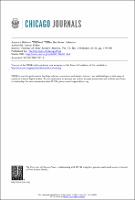Please use this identifier to cite or link to this item:
https://hdl.handle.net/20.500.12202/4440Full metadata record
| DC Field | Value | Language |
|---|---|---|
| dc.contributor.author | Koller, Aaron | |
| dc.date.accessioned | 2019-06-27T17:40:27Z | |
| dc.date.available | 2019-06-27T17:40:27Z | |
| dc.date.issued | 2013 | |
| dc.identifier.citation | Koller, Aaron. (2013). Ancient Hebrew מעצד and עצד in the Gezer Calendar. Journal of Near Eastern Studies, 72(2), 179-193. | en_US |
| dc.identifier.issn | 022-2968 | |
| dc.identifier.uri | http://doi.org/10.1086/671444 | en_US |
| dc.identifier.uri | https://hdl.handle.net/20.500.12202/4440 | |
| dc.description | Scholarly article | en_US |
| dc.description.abstract | (From conclusion): To summarize, therefore, it has been seen that the Hebrew noun מעצד refers to the “adze” throughout the history of ancient Hebrew: it is found twice in the Hebrew Bible, in relatively unrevealing contexts, and often in rabbinic literature, in contexts that make the identification clear. Hebrew is unique among the Semitic languages in having a noun from the root עצד which refers to a carpentry tool; in other languages, cognates refer to agricultural tools and other cutting tools, but not to the tools of the carpenter. Although the literary corpus of Hebrew (Biblical through Mishnaic) does not contain any attestations of the verbal root עצד , this root is attested in the Gezer calendar. Since flax ( פשת ) is “uprooted” rather than “cut,” however, the use of עצד in the Gezer calendar does not match the data regarding the semantics of the root within Hebrew. Instead, I have suggested the connection of Gezer’s עצד with Aramaic חצד , and posit that in the dialect of the scribe, the ע and the ח were indistinguishable, at least in some contexts. | en_US |
| dc.description.sponsorship | A very early form of some of these ideas was subjected to the critical eye of Richard C. Steiner. A rough draft of the paper was read and thoroughly (and appropriately) criticized by Elitzur Avraham Bar-Asher, to whom I owe a large debt of gratitude, and a later, but still undeveloped, draft was much improved by the comments and advice of Shawn Zelig Aster. At a later stage, Gary Rendsburg attentively read the paper and provided me with valuable feedback and critical comments. Further criticisms and suggestions came from Seth Sanders, who forced me to clarify certain statements and lines of the argument, and finally, an anonymous reviewer for JNES challenged some of the basic points in ways which led me to reformulate and sharpen the arguments in what are hopefully more convincing ways. Flaws that remain are likely due to my failure to take the advice of these scholars on some point or another. | en_US |
| dc.language.iso | en_US | en_US |
| dc.publisher | The University of Chicago | en_US |
| dc.relation.ispartofseries | Journal of Near Eastern Studies;72(2) | |
| dc.rights | Attribution-NonCommercial-NoDerivs 3.0 United States | * |
| dc.rights.uri | http://creativecommons.org/licenses/by-nc-nd/3.0/us/ | * |
| dc.subject | verbs | en_US |
| dc.subject | cutting tools | en_US |
| dc.subject | scribes | en_US |
| dc.subject | Adzes | en_US |
| dc.subject | nouns | en_US |
| dc.subject | words | en_US |
| dc.subject | artisans | en_US |
| dc.subject | lexicography | en_US |
| dc.subject | agriculture | en_US |
| dc.title | Ancient Hebrew מעצד and עצד in the Gezer Calendar. | en_US |
| dc.type | Article | en_US |
| local.yu.facultypage | https://www.yu.edu/faculty/pages/koller-aaron | |
| Appears in Collections: | Yeshiva College: Faculty Publications | |
Files in This Item:
| File | Description | Size | Format | |
|---|---|---|---|---|
| מעצד JNES 72 (2013).pdf | PDF author | 455.84 kB | Adobe PDF |  View/Open |
This item is licensed under a Creative Commons License

